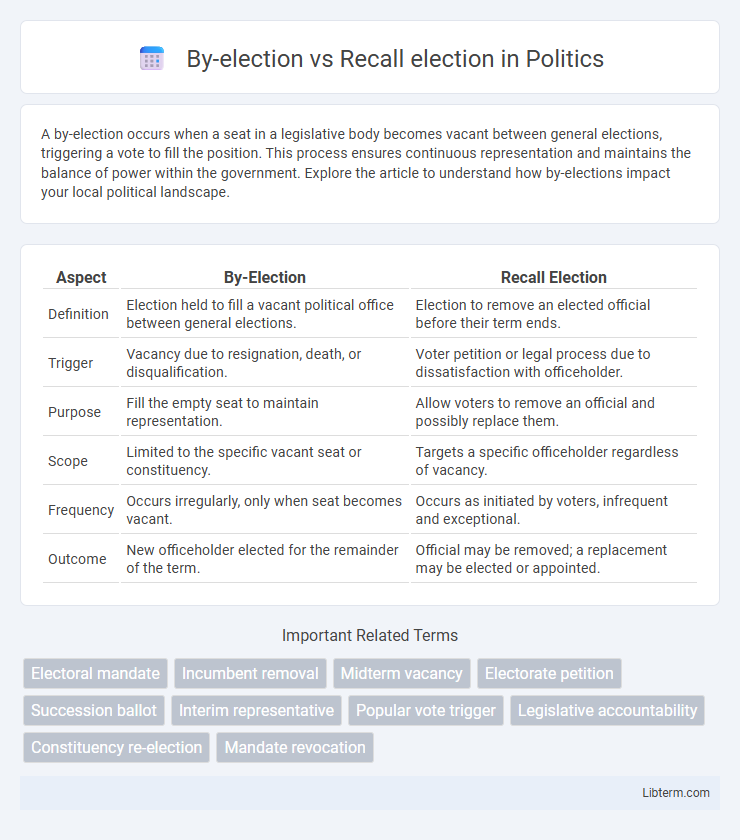A by-election occurs when a seat in a legislative body becomes vacant between general elections, triggering a vote to fill the position. This process ensures continuous representation and maintains the balance of power within the government. Explore the article to understand how by-elections impact your local political landscape.
Table of Comparison
| Aspect | By-Election | Recall Election |
|---|---|---|
| Definition | Election held to fill a vacant political office between general elections. | Election to remove an elected official before their term ends. |
| Trigger | Vacancy due to resignation, death, or disqualification. | Voter petition or legal process due to dissatisfaction with officeholder. |
| Purpose | Fill the empty seat to maintain representation. | Allow voters to remove an official and possibly replace them. |
| Scope | Limited to the specific vacant seat or constituency. | Targets a specific officeholder regardless of vacancy. |
| Frequency | Occurs irregularly, only when seat becomes vacant. | Occurs as initiated by voters, infrequent and exceptional. |
| Outcome | New officeholder elected for the remainder of the term. | Official may be removed; a replacement may be elected or appointed. |
Introduction to By-elections and Recall Elections
By-elections fill vacancies in legislative bodies between general elections, triggered by events such as resignation or death of an incumbent. Recall elections enable voters to remove elected officials from office before their term ends, usually through a petition process followed by a vote. Both mechanisms serve as tools for maintaining democratic accountability and representation.
Definition of By-election
A by-election is a localized election held to fill a political office that becomes vacant between general elections, often due to resignation, death, or disqualification of the incumbent. It ensures continued representation for the affected constituency without waiting for the next scheduled general election. Unlike recall elections, which are initiated by voters aiming to remove an official before their term ends, by-elections focus solely on filling unexpected vacancies.
Definition of Recall Election
A recall election is a political process that allows voters to remove an elected official from office before their term ends, typically triggered by a petition demonstrating sufficient public support. This form of direct democracy contrasts with a by-election, which occurs solely to fill a vacant seat following events like resignation or death. Recall elections emphasize accountability and provide a mechanism for constituents to challenge and potentially overturn an official's mandate during their term.
Key Differences Between By-elections and Recall Elections
By-elections fill vacant political offices due to resignation, death, or disqualification, while recall elections allow voters to remove an elected official before the end of their term. By-elections follow scheduled procedures triggered by office vacancies, whereas recall elections require a petition process initiated by voters demanding a vote on the official's removal. The key difference lies in purpose: by-elections maintain governance continuity by replacing officials, recall elections serve as a direct democratic tool to hold incumbents accountable.
Legal Framework and Eligibility
By-elections are held to fill vacancies in legislative bodies due to resignation, death, or disqualification, governed by specific electoral laws that set nomination deadlines and campaign regulations. Recall elections allow voters to remove an elected official before their term ends, requiring petition thresholds and adherence to legal criteria defined by state or national law. Eligibility for candidates in by-elections typically mirrors general election requirements, while recall elections focus on the validity of removal grounds and voter eligibility to initiate the recall process.
Triggers and Circumstances for Each Election Type
By-elections are triggered primarily by the vacancy of a legislative seat due to resignation, death, or disqualification of the incumbent, ensuring continued representation for the affected constituency. Recall elections occur when voters initiate a petition process to remove an elected official before the end of their term, typically due to dissatisfaction with performance or misconduct. The circumstances for by-elections are usually unplanned and reactive, while recall elections are proactive measures driven by voter mobilization and political accountability.
Electoral Process: By-election vs Recall Election
A by-election occurs to fill a vacant seat in a legislative body between general elections, triggered by resignation, death, or disqualification of an incumbent, ensuring continuous representation. Recall elections empower voters to remove an elected official before their term ends through a petition and subsequent vote, serving as a direct accountability mechanism. Both processes involve voter participation but differ in purpose: by-elections fill vacancies, while recall elections address performance or conduct concerns of sitting officials.
Impact on Political Stability
By-elections fill vacant legislative seats, ensuring continuous representation but may temporarily shift political power dynamics and cause short-term instability. Recall elections enable voters to remove elected officials before term completion, potentially disrupting government functions and creating uncertainty. Both election types influence political stability by altering leadership continuity and impacting policymaking processes.
Case Studies: Notable Examples Worldwide
The 2019 UK by-election in Brecon and Radnorshire marked a significant political shift when the Liberal Democrats won a previously Conservative seat, illustrating how by-elections can alter parliamentary dynamics. In contrast, the 2012 recall election in Wisconsin triggered by Governor Scott Walker's controversial policies highlighted the power of recall mechanisms in holding elected officials accountable mid-term. These case studies underscore the strategic use of by-elections and recall elections in different political systems worldwide to either fill vacancies or remove officials through direct voter intervention.
Conclusion: Choosing Between By-election and Recall Election
Choosing between a by-election and a recall election depends on the specific circumstances and objectives of the electoral process. By-elections are typically held to fill vacant seats due to resignation, death, or disqualification, ensuring representation continuity, while recall elections allow voters to remove an elected official before their term ends, reflecting direct accountability. The decision should weigh factors such as urgency, legal frameworks, voter engagement, and political stability to determine the most appropriate electoral mechanism.
By-election Infographic

 libterm.com
libterm.com